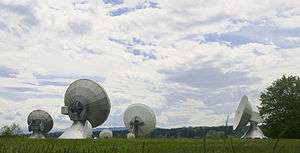Ground station
A ground station, earth station, or earth terminal is a terrestrial radio station designed for extraplanetary telecommunication with spacecraft (constituting part of the ground segment of the spacecraft system), or reception of radio waves from astronomical radio sources. Ground stations may be located either on the surface of the Earth, or in its atmosphere.[1] Earth stations communicate with spacecraft by transmitting and receiving radio waves in the super high frequency or extremely high frequency bands (e.g., microwaves). When a ground station successfully transmits radio waves to a spacecraft (or vice versa), it establishes a telecommunications link. A principal telecommunications device of the ground station is the parabolic antenna.

Ground stations may have either a fixed or itinerant position. Article 1 § III of the ITU Radio Regulations describes various types of stationary and mobile ground stations, and their interrelationships.[2]
Specialized satellite earth stations are used to telecommunicate with satellites—chiefly communications satellites. Other ground stations communicate with manned space stations or unmanned space probes. A ground station that primarily receives telemetry data, or that follows a satellite not in geostationary orbit, is called a tracking station.
When a satellite is within a ground station's line of sight, the station is said to have a view of the satellite (see pass). It is possible for a satellite to communicate with more than one ground station at a time. A pair of ground stations are said to have a satellite in mutual view when the stations share simultaneous, unobstructed, line-of-sight contact with the satellite.[3]
Telecommunications port
A telecommunications port—or, more commonly, teleport—is a satellite ground station that functions as a hub connecting a satellite or geocentric orbital network with a terrestrial telecommunications network, such as the Internet.
Teleports may provide various broadcasting services among other telecommunications functions,[4] such as uploading computer programs or issuing commands over an uplink to a satellite.[5]
In May 1984, the Dallas/Fort Worth Teleport became the first American teleport to commence operation.
Earth terminal complexes

In Federal Standard 1037C, the United States General Services Administration defined an earth terminal complex as the assemblage of equipment and facilities necessary to integrate an earth terminal (ground station) into a telecommunications network.[6][7] FS-1037C has since been subsumed by the ATIS Telecom Glossary, which is maintained by the Alliance for Telecommunications Industry Solutions, an international, business-oriented, non-governmental organization. The Telecommunications Industry Association also acknowledges this definition.
Satellite communications standards
The ITU Radiocommunication Sector (ITU-R), a division of the International Telecommunication Union, codifies international standards agreed-upon through multinational discourse. From 1927 to 1932, standards and regulations now governed by the ITU-R were administered by the International Consultative Committee for Radio.
In addition to the body of standards defined by the ITU-R, each major satellite operator provides technical requirements and standards that ground stations must meet in order to communicate with the operator's satellites. For example, Intelsat publishes the Intelsat Earth Station Standards (IESS) which, among other things, classifies ground stations by the capabilities of their parabolic antennas, and pre-approves certain antenna models.[8] Eutelsat publishes similar standards and requirements, such as the Eutelsat Earth Station Standards (EESS).[9][10]
The Teleport (originally called a Telecommunications Satellite Park) innovation was conceived and developed by Joseph Milano in 1976 as part of a National Research Council study entitled, Telecommunications for Metropolitan Areas: Near-Term Needs and Opportunities."
Major Earth stations and Earth terminal complexes
- Bukit Timah Satellite Earth Station, Singapore
- Canberra Deep Space Communication Complex, Australia
- Esrange Satellite Station at Esrange, Sweden
- Goldstone Deep Space Communications Complex, California, US
- Goonhilly Satellite Earth Station, UK
- Honeysuckle Creek Tracking Station, Australia
- Jamesburg Earth Station (abandoned), California, US
- Kaena Point Satellite Tracking Station, Hawaii, US
- Madley Communications Centre, UK
- Madrid Deep Space Communication Complex, Spain
- Makarios Earth Station, Cyprus
- Suparco Satellite Center, Pakistan
- Svalbard Satellite Station, Norway
See also
- Antenna farm
- Fundamental station
- Geosynchronous orbit
- Ground segment
- List of astronomical observatories
- Mission control center
- Observatory
- Pass (spaceflight), the period in which a spacecraft is above the local horizon
- Radio astronomy
- Radio telescope
- Satellite geodesy#Satellite tracking
- Satellite truck
- SatNOGS
References
- "Earth station", Federal Standard 1037C, General Services Administration, 1996, retrieved 2009-04-23
- ITU Radio Regulations – Article 1, Definitions of Radio Services, International Telecommunication Union, archived from the original on 2009-04-30, retrieved 2009-04-23
- Underkoffler, C.; Webster, A.; Colombo, A., eds. (2007), "View", ATIS Telecom Glossary, Alliance for Telecommunications Industry Solutions, retrieved 2009-04-22
- "Glossary" (PDF). Archived from the original (PDF) on July 16, 2011. Retrieved April 25, 2009.
- "Satellite Teleport". Archived from the original on March 5, 2009. Retrieved April 25, 2009.
- "Earth terminal complex", Federal Standard 1037C, General Services Administration, 1996, retrieved 2009-04-22
- Underkoffler, C.; Webster, A.; Colombo, A., eds. (2007), "Earth terminal complex", ATIS Telecom Glossary, Alliance for Telecommunications Industry Solutions, retrieved 2009-04-22
- Intelsat Earth Station Standards (IESS) – Document IESS–207 (Rev. 4) (PDF), Eutelsat Communications, 2005-05-10, archived from the original (PDF) on 2006-10-17, retrieved 2009-04-22
- Earth Station Minimum Technical and Operational Requirements (Standard M, EESS 502 Issue 11 Rev 1), Eutelsat Communications, archived from the original on 2009-02-28, retrieved 2009-04-22
- Eutelsat Approved Equipment, Eutelsat Communications, archived from the original on 2008-11-17, retrieved 2009-04-22
External links
- UplinkStation.com, a corporate directory of commercial teleports, satellite television operators, et al. Accessed on 22 April 2009.
- World Teleport Association Accessed on 22 April 2009.